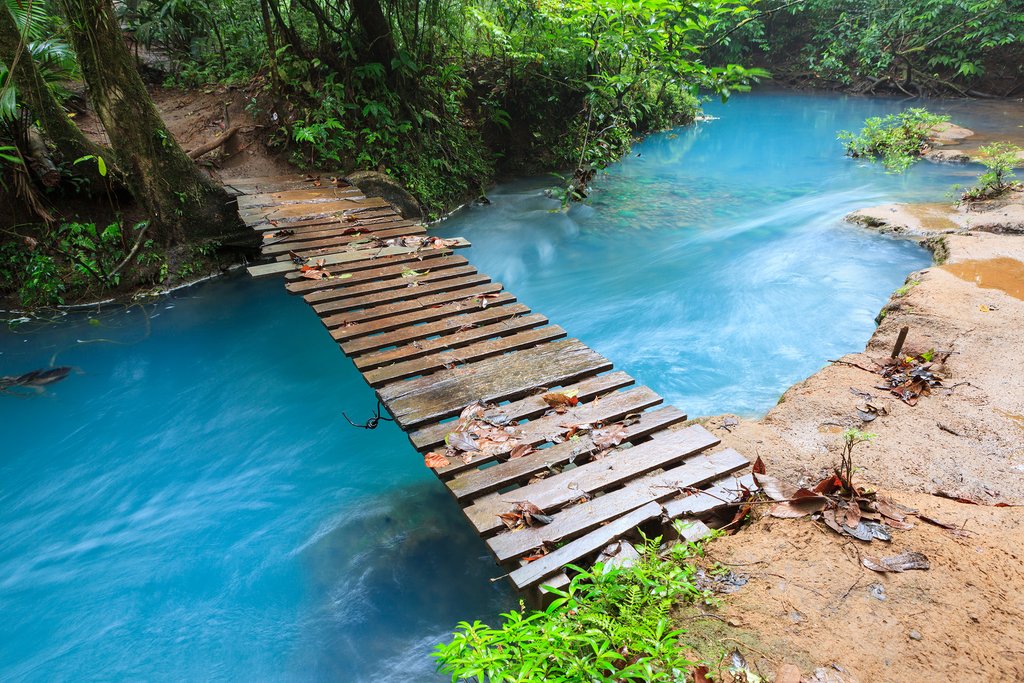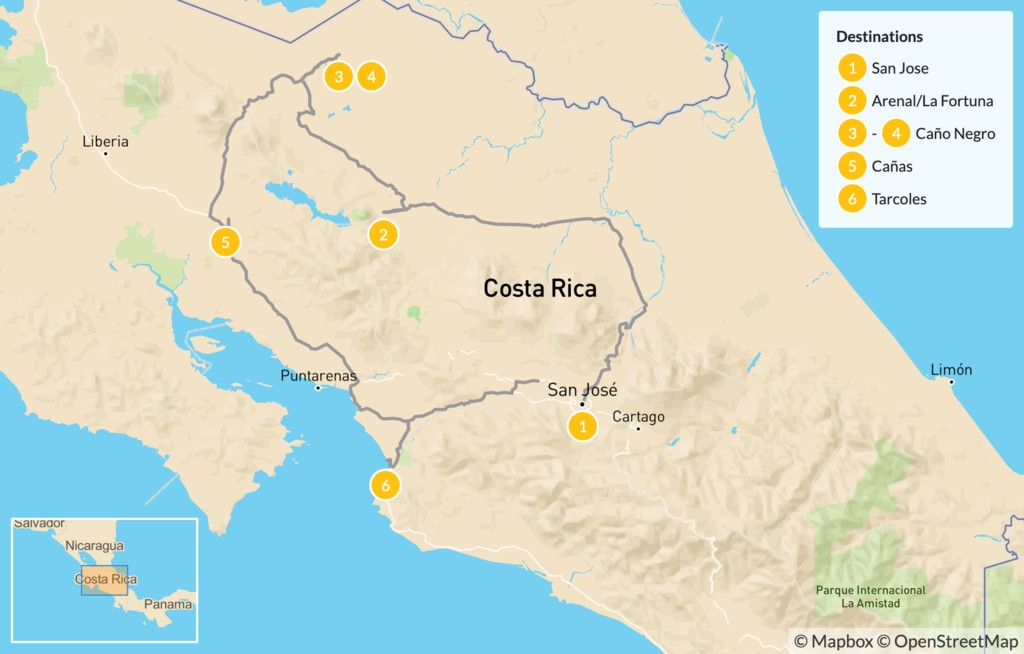Highlights
- Go birding in Arenal Volcano National Park
- View exotic species in the wetlands of the Caño Negro Wildlife Refuge
- Hike alongside sky blue rivers in Tenorio National Park
Brief Itinerary
| Day | Highlights | Overnight |
|---|---|---|
| Day 1 | Arrive in Costa Rica - Experience San José's Culture and History | San Jose |
| Day 2 | Birding at Vara Blanca - Transfer to La Fortuna/Arenal | Arenal/La Fortuna |
| Day 3 | Arenal to Caño Negro | Caño Negro |
| Day 4 | Early-Morning Birding at Caño Negro | Caño Negro |
| Day 5 | Caño Negro to the Celeste River & Tenorio National Park | Cañas |
| Day 6 | Palo Verde National Park - Travel to Tárcoles | Tarcoles |
| Day 7 | Tárcoles to San José - Departure |
Detailed Itinerary
Day 1: Arrive in Costa Rica - Experience San José's Culture and History

Welcome to Costa Rica, the land of pura vida! After arriving at Juan Santamaría International Airport in San José, a local representative will meet you and escort you to your hotel. The rest of the day you'll have free to explore the city at your leisure.
Perhaps take a stroll through Mercado Central (Central Market), which features over 200 shops, food stalls, and sodas (traditional restaurants). Then visit the Catedral Metropolitana (Metropolitan Church), whose interior combines Greek Orthodox, neoclassical, and Baroque styles. There's also a pair of popular museums in San José: Museo del Oro Precolumbino (Pre-Columbian Gold Museum), and Museo del Jade, which houses the world's largest collection of pre-Columbian jade artifacts.
Be sure to explore Barrio Amón, a bohemian neighborhood home to historic cafetalero (coffee grower) mansions built during the late 19th and early 20th centuries. For dinner, opt for a restaurant in the hills of Escazú. This elevated region on the western edge of the city offers panoramic views of the valley below. That said, San José is filled with great restaurants serving everything from traditional Costa Rican fare to forward-thinking fusion cuisine.
Day 2: Birding at Vara Blanca - Transfer to La Fortuna/Arenal

After breakfast at your hotel, you'll meet your English-speaking guide and embark on a great Costa Rica birding adventure. The first stop is the highland village of Vara Blanca, which is located just north of San José, on the Continental Divide between the volcanoes of Poás and Barva. All told, you'll spend about 1.5 hours enjoying some fantastic birding outside of the village. Common varieties include the fiery-throated hummingbird, barred hawk, ornate hawk-eagle, chestnut-mandibled toucan, tanager, and flycatcher.
Afterward, you'll drive north two hours to the town of La Fortuna, the gateway to Arenal Volcano National Park. You won't miss the namesake volcano—Arenal juts 5,479 feet (1,670 meters) out of the ground like an arrowhead. Upon arrival, you'll check into the Arenal Observatory Lodge, which sits on 870 acres of rainforest with its own bird sanctuary home to around 500 species. The prime vantage point is a 92-foot (28-meter) tower where you can observe birds like herons, trogons, and red-lored parrots.
For dinner, you can dine on Costa Rican and international cuisine at the Arenal Observatory Restaurant, which offers its own stunning views of Lake Arenal.
Day 3: Arenal to Caño Negro

In the morning you'll transfer 2.5 hours to the far north of the country, stopping at times to take birding breaks at ideal vantage points. Today's destination is the Caño Negro Wildlife Refuge, which, comprising 24,612 acres (9,960 hectares), is the largest wetland in the country. Within its boundaries are lagoons, rivers, rainforest, and tiny villages, making it ideal birding territory as the area lies in a key migratory route for northern birds.
Upon arrival, you'll check-in to your eco-lodge and then head out and explore. There's good birding around the property, as it features dense bushes and tall trees amid secondary rainforest. These conditions attract many species like the spot-breasted wren, greenish elaenia, cinnamon woodpecker, yellow-throated euphonia, red-legged honeycreeper, black-cheeked woodpecker, and red-lored parrot, to name a few.
Chat with a local specialist who can help organize your trip.
Day 4: Early-Morning Birding at Caño Negro

Today you'll enjoy one of the most exciting birding tours in the country. The Caño Negro Wildlife Refuge is known for its incredible diversity of resident birds as well as being the winter home for thousands of returning migratory birds. On this tour, you'll observe many species found only in this unique ecosystem.
Some birds you can spot include kingfishers, cormorants, anhingas ("snakebird"), southern lapwings, black-bellied whistling-ducks, black-necked stilts, purple gallinules, russet-naped wood-rails, yellow-breasted crakes, black-collared hawks, lesser yellow-headed vultures, snail kites, bat falcons, agami herons, little blue herons, great egrets, tricolored herons, boat-billed herons, and many others.
This is a three-hour tour accompanied by a local guide who will lead you to the best vantage points. After the tour, you'll return to your hotel. Since you'll have the afternoon free, you can choose between a number of other tours/activities in the Caño Negro Wildlife Refuge such as a wetlands boat tour, sport-fishing excursion, or nocturnal nature walk.
Day 5: Caño Negro to the Celeste River & Tenorio National Park

In the morning, you'll leave the northern plains and travel southwest toward the Pacific coast, stopping along the way at the Rio Celeste and Tenorio National Park. The road heading into the national park offers good birding, as it's home to various species like the lovely cotinga, black hawk-eagle, white-fronted nunbird, keel-billed motmot, sunbittern, yellow-eared toucanet, and the lattice-tailed trogon.
Then you'll visit one of the most incredible sights in the country: the sky blue Río Celeste, located inside the park. Local legend has it that after God was done painting the sky he washed his paintbrushes in this river, hence the name, which translates to "river of the sky." The scientific explanation says the vivid blue color is due to a mixture of sulfur and carbonate, which originates in the dormant Tenorio Volcano.
You'll embark on a four-mile (seven-kilometer) hike on a trail that runs along the Celeste, passing many sites of interest like the river's famous waterfall and the Blue Lagoon, a natural turquoise pool. Later, you'll stop at a viewpoint with vistas of the Tenorio Volcano. But it's not just incredible landscapes you'll enjoy; Tenorio National Park is a great birding destination too. Here you'll find species like the violaceous quail-dove, black-eared wood-quail, rufous-vented ground-cuckoo, and more.
Day 6: Palo Verde National Park - Travel to Tárcoles

After breakfast, you and your guide will transfer 45 minutes south to Palo Verde National Park. This large protected area (some 49,000 acres) is unique in that it's home to both tropical dry forest as well as wetlands. Before entering the park there are rice fields where you'll find good concentrations of wood storks. Also here are the black-necked stilt, great egret, and solitary sandpiper. During the migratory months, you'll see bobolinks, dickcissels, and many more species.
Once inside the park, you can view an even greater variety of exotic specimens. There's the thicket tinamou, fulvous whistling duck, northern shoveler, least bittern, glossy ibis, jabiru, hook-billed kite, northern harrier, white-tailed hawk, mangrove cuckoo, and the scrub euphonia. After birding, you'll continue to the central Pacific coast and the town of Tárcoles. Sitting on the banks of the river of the same name, Tárcoles is known for its scarlet macaws and giant crocodiles.
Day 7: Tárcoles to San José - Departure

This morning you'll enjoy one last leisurely breakfast in Costa Rica. At the appropriate time, you will transfer about an hour by road back to San José and the international airport, where you'll catch your flight home. Come back soon!


